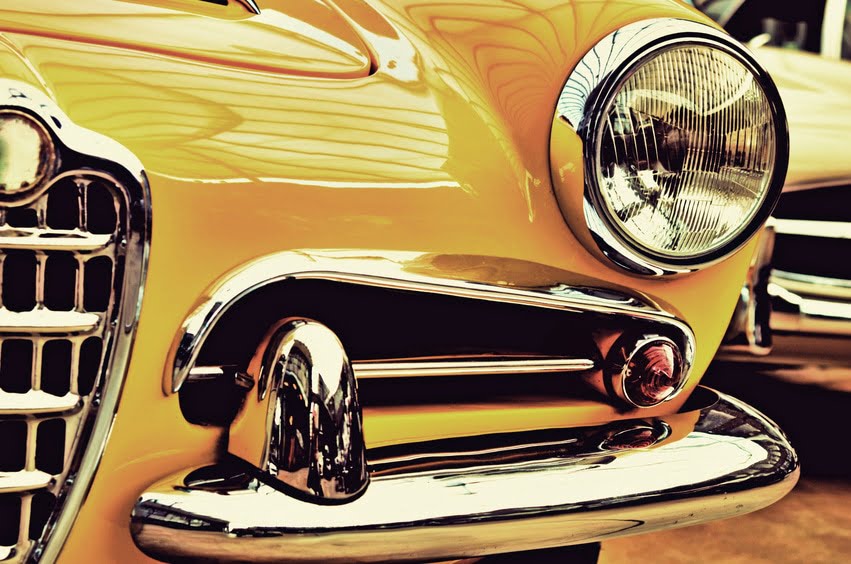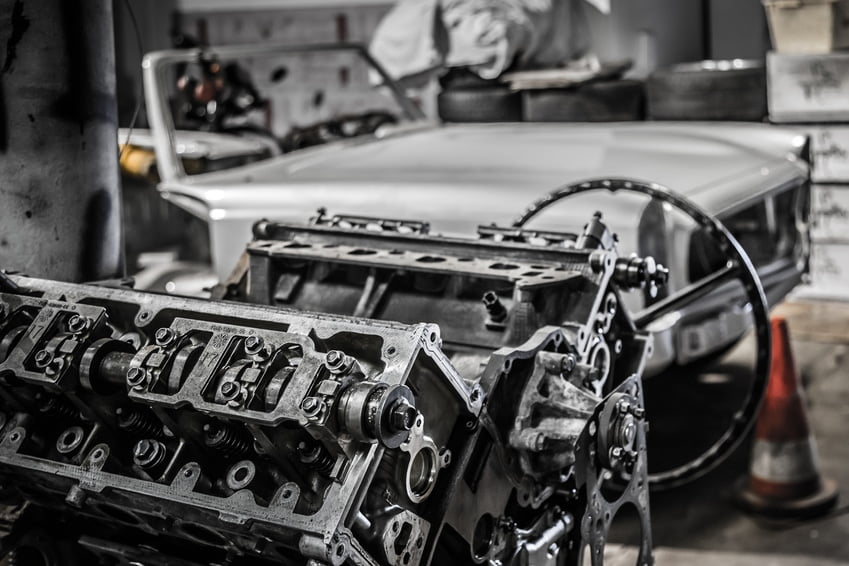Whatever your motivation for restoring a classic car, it is the ultimate labour of love, requiring time, patience, skill and of course, a good garage or workshop with the right tools for the job. For a classic car lover, bringing a car back to life is a rewarding experience, and one that could see you turn a profit when you sell the car on.
Original classic cars are becoming a rarity in the UK, with many being too expensive for the average collector. This means more classic car enthusiasts are turning to restoration as a way of affordably owning their dream car. But as with all dreams and ambitions, there’s work to be done before you stand back and admire your handiwork — with the average classic car restoration taking at least 1,000 hours to complete.
In this guide, we’ll offer advice on what to consider when starting a classic car restoration project, and provide practical mechanical advice to help you get started. The guide is designed for people who’ve never restored an old car, to point you in the right direction no matter what your previous experience or skills.
- Classic Car Restoration: Laying the Groundwork
- Mechanical Considerations
- Is Restoring an Old Car a Viable Option?
- Simoniz Top Tips for Car Restoration
- How to Clean a Classic Car with Care
Classic Car Restoration: Laying the Groundwork
Restoring a car is a big commitment, and it’s easy to underestimate things like material costs and the price of tools needed to carry out certain jobs. That’s why it’s important to do your homework before splashing out on an old car.
Time and Money
If you don’t have enough time on your hands, your project will be destined to fail from the off, or else stall long enough to sap the enjoyment out of the whole experience. Make sure you can concentrate fully on the project, without it interfering with your family or work life.
And as for cost, the average classic car restoration costs anywhere between £15,000 and £40,000, including the price of buying the car and all of the tools and materials needed. Of course, this is just a ballpark, and your project could cost more or less depending on the car you buy and how much work is required.
It’s worth giving yourself a budget and finding a car which suits it (in terms of the upfront cost and how much you estimate you’ll have to spend on it) rather than falling in love with a car and budgeting around it. That said it should also be a car that you feel excited about, as you’re going to be investing a lot of energy into it.
Finding the Perfect Car
This brings us to one of the hardest parts of classic car renovation — finding the right car to work on in the first place. Choosing a car that can be restored to a high standard while keeping costs down is a balancing act, so shop around and get advice from fellow enthusiasts on classic car renovation forums like OldClassicCar.co.uk.
One of the best places to start your search is classified ads, either in your local paper or online. Sites like eBay and Gumtree can prove a hotbed for bargain classic cars, but make sure you view the car before agreeing to buy. There are also sites out there dedicated to selling quality classic cars in need of renovation, including CarandClassic.co.uk, which features hundreds of old cars from every major manufacturer. In short, do plenty of research online ahead of any major buying decision.
When viewing a classic car, there are a few things to look for which tell you about its condition and how easy it’ll be to restore. As a rule, only buy a complete car that’s solid and free from major damage and rust. While it’s possible to replace parts and fix problems, the cost could spiral.
Tip: If you need to source replacement parts, forums like the one we mentioned earlier are a great place to search for the cheapest deals as recommended by fellow classic car enthusiasts.
Space, Tools and Equipment
Unless you plan to outsource your restoration project to a classic car specialist, the biggest outlay you’ll face is investing in the tools, equipment and materials needed to complete the renovation to a high standard — and that’s after you’ve found a space large enough to act as a workshop.
Here, we list the tools you’re likely to need over the course of the project. Knowing which tools to buy before you start will not only help you to keep a grip of the budget, it’ll save you buckets of time and energy:
- Screwdrivers
- Pliers
- Sockets and a wrench
- Sheet metal scissors
- A drill and drill bits
- Wire brushes
- Floor jack
- Electrical tools (air compressor, voltage checker etc.)
As well as these simple tools, you may also need access to the following:
- Engine crane and engine stand
- Jack stands
- Grinder
- Blowtorch
- Welder
To save on costs we’d recommend hiring these tools when they’re needed. Some of the tools require specialist skill and knowledge, so be prepared to get help with certain jobs or else invest in a training course to carry out the work yourself.
It goes without saying, but it’s also important that you have a garage or workshop space that’s clean, dry and suitable for storing, as well as providing access and suitable space for working on your car throughout the year!
Originality vs. Personality
A debate that has long raged in the world of classic cars is whether to restore a car to its original condition or add your own flair and personality to the mix.
Restoration purists would argue that classic cars should be bought back to the condition they were in when rolling off the production line, with everything from the gear stick to the exhaust tailpipe refashioned to resemble the original component.
But, while it’s true absolute originality will fetch a higher price when it comes to selling the car on, we think it’s better to go with your gut and inject personal touches as you go. The car should be modified to please you, not the next buyer, so don’t be afraid to choose the colours and design choices you like over those pre-assigned by the car’s original appearance.
Mechanical Considerations
Assuming you’ve acquired a humble old ‘fixer-upper’ and have the space, tools, time and money to restore it from boot to bonnet, it’s time to think about what work is required to reinstate its original charm and showroom shine.
Body and Paintwork Repair
If there’s one problem most old cars share, it’s damaged paint and bodywork. Even if they’ve been well looked after, classic cars have a tendency to develop faded paintwork as well as damage in the form of rust spots or dinks.
For the most satisfying and effective results, you’ve got to tackle body and paint restoration head on. There’s no shortcut when it comes to restoring paintwork and body panels, and learning how to hammer out dents and rebuild body panels from scratch requires patience and practise.
If you’re serious about mastering the art of classic car restoration, why not invest in a welding and metalwork course? Lending you the skills to sculpt brand new body panels for your car out of sheet metal, a metalworking course is a worthwhile investment if you want the satisfaction of completing the whole project yourself.
Seized Components
Even if an old car looks OK on the outside, you can almost guarantee there’ll be something than needs attention beneath the bonnet. When left to stand for a long period, moving parts seize due to corrosion and decay. Fluids such as transmission and brake fluid need to be changed at least every two years, or else the systems are liable to fail. If your old car has been left to rot in a shed for years, you might find you have to repair or replace most of its moving parts.
Electrics
Without regular charging, a car’s battery will go flat in around 4 weeks, and less than that in winter. When left dormant for three months or longer, charging the battery may not be enough to bring it back to life, so you might need to replace it completely.
As well as this, any electrical components and wiring within the car will need to be checked to make sure they still work. Wires can degrade over time, particularly if they’ve been exposed to moisture. Mice also have a tendency to chew through internal cables, so always cover and secure your car when it’s left standing in the garage or workshop.
Mould
If you spot signs of mould in your car’s interior, don’t write the car off just yet. Surface mould is actually easy to remove from the interior of a car using a regular cabin cleaning product like Simoniz Upholstery and Carpet Cleaner; simply apply the product to the mould and scrub away with a cloth. Be aware, though, that the presence of mould could indicate that the cabin isn’t watertight, and this will need to be plugged to stop mould spreading again in the future.
Is Restoring an Old Car a Viable Option?
To give you the best chance of performing a successful classic car restoration, here are some questions to ask yourself before diving into a new project.
- What is my budget, and have I accounted for the complete cost?? If the answer’s no, it’s time to dig out the calculator and do some sums.
- Do I have space to work and store the car in? If not, consider other options like hiring a workspace or borrowing a family member’s garage.
- What is my timeframe, and how much time will I need to devote to the project each week? Make sure the project doesn’t conflict with your other commitments. Remember, a complete and thorough restoration could take a year or more.
- Do I have the skills and expertise to complete the work to a high standard? Welding and metalwork are just two of the skills you’ll need to restore a car. Invest in training courses or outsource jobs to achieve a great finish.
Simoniz Top Tips for Car Restoration
Simoniz may be a car care specialist first and foremost, but with decades of experience in the motoring industry, we’ve gotten to know a thing or two about vehicle maintenance and restoration too. So, with that in mind, here are a few words of wisdom from our experts – perfect for those at the start of their classic car restoration journey.
- Be prepared to learn: From fitting an engine to welding an axle, restoring a classic car isn’t your average DIY project, so be prepared for some steep learning curves and a lot of trial and error. YouTube is a fantastic resource for quickly learning the basics, but there are also a range of paid-for courses that you may wish to consider too.
- Prepare for potential issues and hurdles: There’s no point in kidding yourself that your car restoration project will be all plain sailing – you’re going to run into issues that won’t even have crossed your mind. The trick is to account for this early on and factor this into your overall budget. That way, any nasty surprises will become a little less, well, nasty.
- Join a classic car club or online community: We can’t stress how beneficial this can be. Being part of a like-minded group of classic car enthusiasts will not only help you get your questions answered but will also provide a constant source of inspiration, moral support, and peace of mind that you’re on the right track. Often, there are clubs for specific makes and models of classic cars too, so be sure to check what’s available.
- Look after your equipment: The bits and pieces you use on your classic car restoration journey will become invaluable allies as you move through the project, so treat tools and equipment with care. Maintaining an organised workspace is half the battle when it comes to classic car restoration, and should help the project to run smoothly.
- Storage is key: Before, during, and after your classic car restoration project, how and where you store your car is critical. Finding the right space and environment is important for all sorts of reasons, not least to safeguard the long-term integrity of your vehicle. Check out our full guide for tips on how to store your classic care safely.
- Be realistic and know your limits: The statement “Rome wasn’t built in a day” rings true in relation to classic car restoration, so don’t expect a quick turnaround free from hold-ups and problems. Patience and time are prerequisites of any restoration project.
- Enjoy yourself! Arguably the most important point to remember when restoring a classic car – it’s supposed to be a fun hobby, after all.
How to Clean a Classic Car with Care
After you’ve spent all that time restoring it, the next step is to keep your classic car clean. Happily, this is very much our area of expertise, so if you’re looking for specialist classic car cleaning and detailing advice, Simoniz has you covered.
Not only are our high-quality car cleaning and care products perfect for use on vintage vehicles, but our blog features tons of helpful guides and resources on cleaning cars inside and out. Be sure to check out our dedicated interior and exterior advice hubs too, for focused tips, products and know-how you can rely on.
Remember, restoring a classic car should be a labour of love, and not a way to make money, so pick a car that you want to own and be prepared for some tough but rewarding work. Simoniz polishes, paints and cleaning products can help you restore your classic car’s appearance and protect it for longer. To find out more, visit the Simoniz website.






